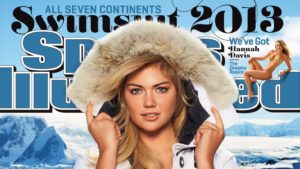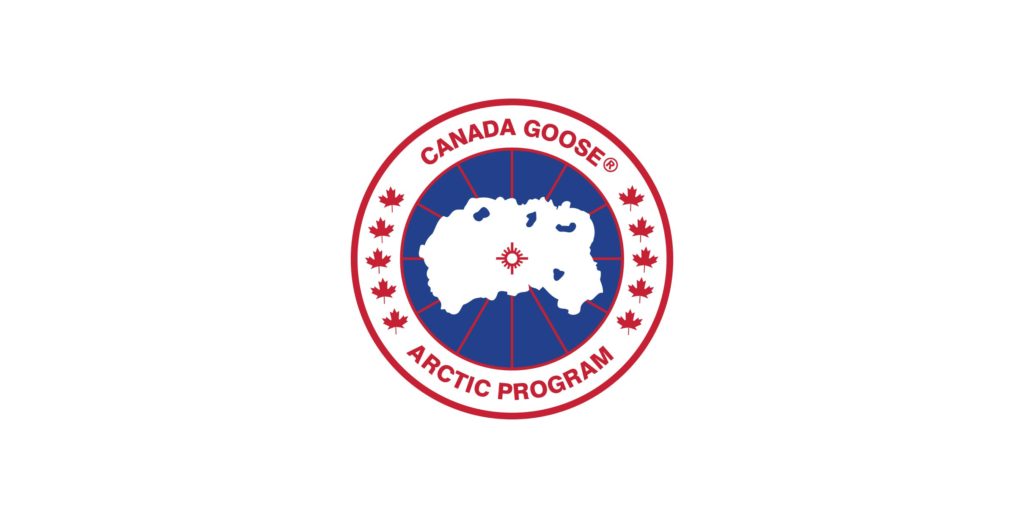The Geese Have Landed in Ann Arbor for the Winter
And these status symbols are here to stay
—By Julia Szydlowski
If you looked at the Sports Illustrated’s Swimsuit cover in 2013, you might have been very impressed by Kate Upton. After you stop looking at her great features, you may notice half a red-white-and-blue patch on her right shoulder. The recognizable logo is attached to a white Canada Goose $595 Chilliwack Bomber. The easily identified coats may be some of the warmest outerwear for these frigid temperatures, especially if you are posing half-naked in the snow like Upton. However, their warmth may not outweigh their outrageous price. The brand’s average parka costs around $800 and the most expensive jackets retail for $1,700.
Adweek and other sources quoted that Upton’s showcase of the fur-trimmed coat is just one of the reasons that have made them hot commodities within the last decade. Due to a company rebrand, product placements, and celebrity partnerships, the brand has become a fashion must-have and a status symbol.
So how did these expensive coats flock their way down from Canada to celebrities shoulders, then to the University of Michigan’s campus and the surrounding Ann Arbor area? Look anywhere on campus in 2019 and you will see an army of bubble coats with the “Arctic Program” emblazoned on their left shoulders. A junior, Kate, confirms that “1 out of every 3 coats I see [on campus] is a Goose.”

How They Got Their Start
Before Kate Upton used the coat to keep warm in a swimsuit in the Arctic Circle, Canada Goose got their start as Metro Sportswear in 1957. The Toronto-based company specialized in cold weather basics for their main customers: city police departments and the Canadian Rangers. In 1970, the owners’ son-in-law David Reiss joined the company and invented the volume-based filling machine to equally pack the coats with famous goose down.
He also went on to change the name to Snow Goose. Yet, the idea was quickly crushed as another company in Europe was operating under that name. In changing the name, Canada Goose quickly cemented themselves as the outerwear brand able to withstand the temperatures of Canadian winters. The pictures of Canadian climbers on Mount Everest and scientists in Antarctica, in the 1980s, provided further support for their reputation as a technical/expedition brand.
The cobalt-blue version, still seen on retail racks today, was a double protective layer for scientists as they were designed to fend off the cold and polar-bear attacks. Apparently, the winter beasts tend to avoid the presence of that color spectrum.
As the color options continued to expand, so did the brand. While they wanted it to remain true to their “ Made in Canada” mission statement, they were looking to expand their current market and approach the American consumers. The transition was slow, as we already had a booming market for costly technical gear from giants such as Patagonia and The North Face. So Reiss did what every other luxury retailer does; he gave the coat to celebrities and allowed them to use their influence to infiltrate the coats into the American consciousness.
Profits and Pop Culture Appearances Soar
By the 2000s, the down jacket was able to sneak its way on screen in two major films: The Day After Tomorrow and National Treasure. Reiss then sponsored cold-weather film festivals and awards ceremonies where the Hollywood celebrities would be pictured in the fur-trimmed coat, an easy transition as the coat was the (un)official uniform for film crews in extreme weather.
Kate Upton’s scantily clad shot in the coat came just about a year after the festival and there has been no shortage of Goose appearances on celebrities since. They have been seen on Daniel Craig, Emma Stone, Tom Hardy, and Rihanna. In the last year, they have also expanded their brand to endear to the growing hip-hop and urban fashion market by collaborating with Drake’s OVO clothing line. Rapper Lil Uzi Vert even produced an ode to the brand titled “Canada Goose.”
From Hollywood to Ann Arbor
So how did the stream of American consciousness continue from celebrities and rappers, to Michigan’s campus? Emmanuel, a junior on campus, says that the coats have “flocked to campus in the past few years or so” since he heard second-hand from one of his professors who would comment about the influx of “geese” on campus. An article from BU Today, where the coats are also increasingly popular, credits careful marketing and celebrities for giving authenticity to the brand’s ability to keep them warm and market it as a status symbol. With a few of the richest and most famous people in America donning the coat, they are perpetuating a mindset credited by Rachel Syme in a piece about the Geese for the New Yorker. “I earned the money, and then I spent the money, and now here I am, warmer than you are.” While not a frequently articulated mindset by Canada Goose, it’s appearance on celebrities’ shoulders and price point marks it as a commodity that only a few can have. And since the brand is known for their exorbitant prices, the coat speaks for itself about one’s socioeconomic status, or at least one’s aspirations.
Susan Fournier, a professor at Boston University’s School of Management, cites that Canada Goose’s target audience of college-age students contributes to its rise on Michigan’s campus. The demographic are a group that interacts with celebrity culture on a daily basis and would be exposed to the mindset and social status associated with Canada Goose. “You want to become a part of the culture”, Fournier started. There is no better place on college campuses that emphasize culture, closeness, and conformity than Greek Life. Katie, a senior on campus, contributed the rise of the coats, with the people who were already in “large groups [clubs, sororities, teams etc.] who already get pulled into purchasing what their friends have to fit in.” With that strong narrative of warmth and connection to social and socioeconomic statuses, it is not surprising that they would get picked up by certain groups. After these groups on campus purchased the coats and wore them frequently, it was a domino effect with the rest of the student body.
Fournier also notes that Canada Goose may be targeting “college students because they might have the ability to afford these things.” She may not be right about all college students. However, at the University of Michigan, the wealth demographic of their parents are consistently increasing. The median income for a students’ family sits around $154,000. However, a New York Times project on economic diversity in universities in America reveals that over 60% of students at the University come from the top 20 percent. Nine percent of the students’ families make over $630,000 a year. With this demographic of students, the coats can be easily afforded by a large part of the student body.
Even though the number of parkas on campus continues to rise and create a sea of coyote-fur trims, some college students do not feel left out. Katie mentioned that she “never gave it a second thought to get one, no pressure, they just seemed too expensive for me to ever purchase.” However, it can be noted that she is not in Greek Life or a larger group.
With Canada Goose’s status in the group culture on campus in combination with the weather for a warm coat, albeit a super expensive one, the Canada Goose coats will continue to be seen on University of Michigan’s campus and on many in the future.

